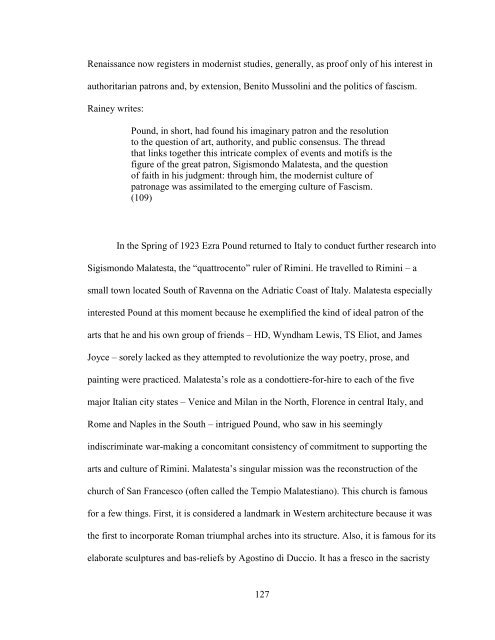TABOO: THE ACTUAL MODERNIST AESTHETIC, MADE REAL A ...
TABOO: THE ACTUAL MODERNIST AESTHETIC, MADE REAL A ...
TABOO: THE ACTUAL MODERNIST AESTHETIC, MADE REAL A ...
Create successful ePaper yourself
Turn your PDF publications into a flip-book with our unique Google optimized e-Paper software.
Renaissance now registers in modernist studies, generally, as proof only of his interest in<br />
authoritarian patrons and, by extension, Benito Mussolini and the politics of fascism.<br />
Rainey writes:<br />
Pound, in short, had found his imaginary patron and the resolution<br />
to the question of art, authority, and public consensus. The thread<br />
that links together this intricate complex of events and motifs is the<br />
figure of the great patron, Sigismondo Malatesta, and the question<br />
of faith in his judgment: through him, the modernist culture of<br />
patronage was assimilated to the emerging culture of Fascism.<br />
(109)<br />
In the Spring of 1923 Ezra Pound returned to Italy to conduct further research into<br />
Sigismondo Malatesta, the ―quattrocento‖ ruler of Rimini. He travelled to Rimini – a<br />
small town located South of Ravenna on the Adriatic Coast of Italy. Malatesta especially<br />
interested Pound at this moment because he exemplified the kind of ideal patron of the<br />
arts that he and his own group of friends – HD, Wyndham Lewis, TS Eliot, and James<br />
Joyce – sorely lacked as they attempted to revolutionize the way poetry, prose, and<br />
painting were practiced. Malatesta‘s role as a condottiere-for-hire to each of the five<br />
major Italian city states – Venice and Milan in the North, Florence in central Italy, and<br />
Rome and Naples in the South – intrigued Pound, who saw in his seemingly<br />
indiscriminate war-making a concomitant consistency of commitment to supporting the<br />
arts and culture of Rimini. Malatesta‘s singular mission was the reconstruction of the<br />
church of San Francesco (often called the Tempio Malatestiano). This church is famous<br />
for a few things. First, it is considered a landmark in Western architecture because it was<br />
the first to incorporate Roman triumphal arches into its structure. Also, it is famous for its<br />
elaborate sculptures and bas-reliefs by Agostino di Duccio. It has a fresco in the sacristy<br />
127
















